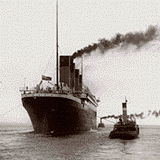 After
spending the day conducting sea trials, the Titanic left Belfast
on the evening of April 2, 1912 for the first point of embarkation before
her maiden voyage - Southampton, England. She arrived the morning of
April 3, at the newly constructed White Star Dock, built specifically to
accommodate both the Olympic and Titanic. As she
approached the docks, she was guided by five tugs as she slowly reached
her quay. The Titanic would spend about one week in
Southampton for preparations and final accommodations. After short
stops in Cherbourg, France and Queenstown (now Cobh), Ireland, The Titanic
would be ready to begin her first crossing of the Atlantic to her final
destination - New York.
After
spending the day conducting sea trials, the Titanic left Belfast
on the evening of April 2, 1912 for the first point of embarkation before
her maiden voyage - Southampton, England. She arrived the morning of
April 3, at the newly constructed White Star Dock, built specifically to
accommodate both the Olympic and Titanic. As she
approached the docks, she was guided by five tugs as she slowly reached
her quay. The Titanic would spend about one week in
Southampton for preparations and final accommodations. After short
stops in Cherbourg, France and Queenstown (now Cobh), Ireland, The Titanic
would be ready to begin her first crossing of the Atlantic to her final
destination - New York. Although coal was scarce in Southampton because of a six-week nationwide coal miners’ strike, White Star was determined to have the Titanic sail on schedule, at noon on Wednesday, April 10. To fuel her for the voyage, White Star filled her bunkers with 4,427 tons of coal scavenged from six other ships whose crossings had been canceled because of the strike. Some officers, crew members and passengers were also transferred from those liners to the brand new ship Titanic.
 Southampton
was the principal of the three points of embarkation for passengers and
crew, and was where she would receive the majority of her provisions for
her first crossing of the Atlantic. Accommodating over two thousand
people for nearly a week was no small task. Food and drink alone
would include 40 tons of potatoes, over 6,000 pounds of butter and over
two tons of coffee. In addition, 20,000 bottles of beer and stout
and 15,000 bottles of mineral water would help to quench the thirst of the
Titanic's passengers. She would also be carrying hundreds
of sacks of mail. The prefix "R.M.S." meaning "Royal
Mail Steamer" indicated that she was legally commissioned by the
British Monarchy, as well the United States, to carry mail.
Southampton
was the principal of the three points of embarkation for passengers and
crew, and was where she would receive the majority of her provisions for
her first crossing of the Atlantic. Accommodating over two thousand
people for nearly a week was no small task. Food and drink alone
would include 40 tons of potatoes, over 6,000 pounds of butter and over
two tons of coffee. In addition, 20,000 bottles of beer and stout
and 15,000 bottles of mineral water would help to quench the thirst of the
Titanic's passengers. She would also be carrying hundreds
of sacks of mail. The prefix "R.M.S." meaning "Royal
Mail Steamer" indicated that she was legally commissioned by the
British Monarchy, as well the United States, to carry mail.